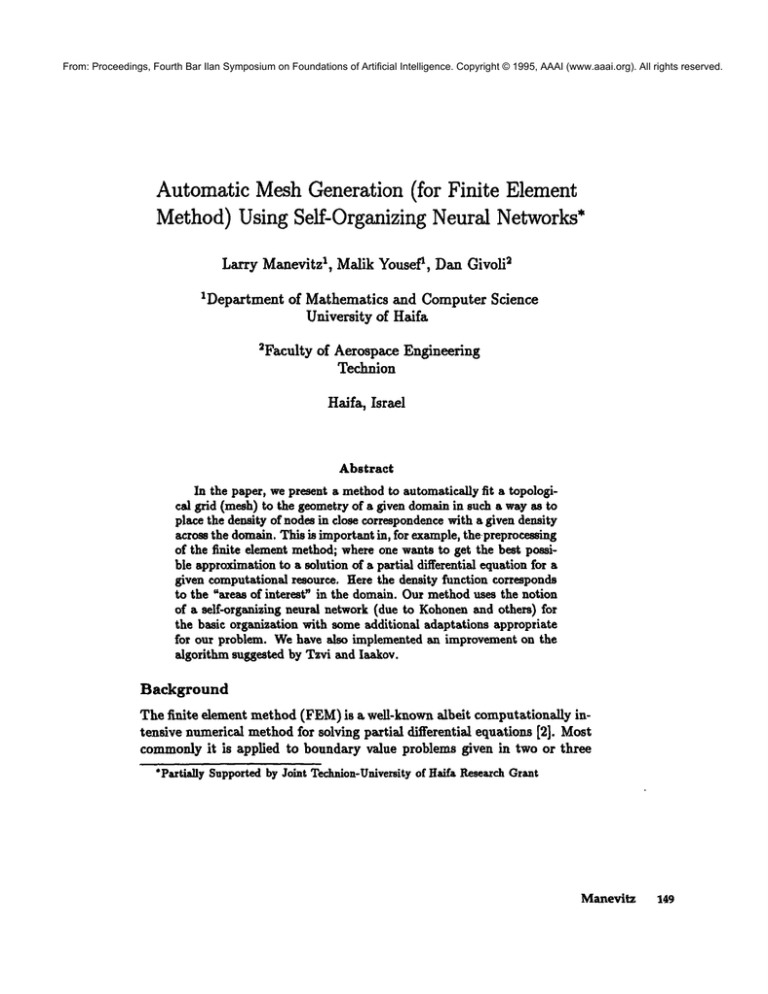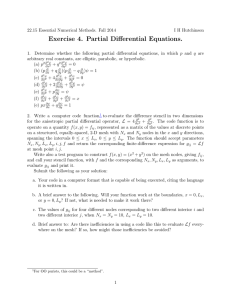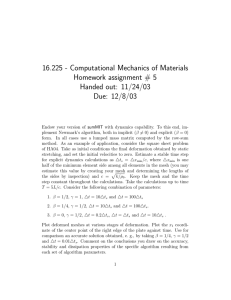
From: Proceedings, Fourth Bar Ilan Symposium on Foundations of Artificial Intelligence. Copyright © 1995, AAAI (www.aaai.org). All rights reserved.
Automatic MeshGeneration (for Finite Element
Method)Using Self-Organizing Neural Networks*
Larry Manevitz1, Malik Yousef1, ~
Dan Givoli
1Department of Mathematics and Computer Science
University of Haifa
2Faculty of Aerospace Engineering
Technion
Haifa, Israel
Abstract
In the paper, we present a method to automatically fit a topological grid (mesh) to the geometry of a given domain in such a way as
place the density of nodes in close correspondence with a given density
across the domain. This is important in, for example, the preprocessing
of the finite element method; where one wants to get the best possible approximation to a solution of a partial differential equation for a
given computational resource. Here the density function corresponds
to the ~areas of interest" in the domain. Our method uses the notion
of a self-organizing neural network (due to Kohonenand others) for
the basic organization with some additional adaptations appropriate
for our problem. We have also implemented an improvement on the
algorithm suggested by Tzvi and Iaakov.
Background
The finite element method (FEM) is a well-known albeit comput*.tionafly intensive numerical method for solving partial differential
equations [2]. Most
commonly it is applied to boundary value problems given in two or three
"Partially Supported by Joint Techaion-University of Haifa Research Grant
Manevitz 149
From: Proceedings, Fourth Bar Ilan Symposium on Foundations of Artificial Intelligence. Copyright © 1995, AAAI (www.aaai.org). All rights reserved.
spatial dimensions. To use the method however, one has to divide up the
available computational resources in an appropriate manner, the different
stages of which typically require expertise.
In more detail, when applying the FEMto a given domain, one has to
divide the domain into a finite number of non-overlapping subdomains (elements). (In two dimensions, the elements are usually triangles or quadrilaterals.) One also has to define a finite number of nodes, which are the
vertices of the elements, and possibly other points as well. The collections
of elements and nodes (and the connections among them) constitute the
finite element mesh, whichis an essential input for all finite element codes.
See, e.g. [2] for details.
To accomplish this, one has to decide on the appropriate size and topoiogy of the mesh and decide how it should be placed on the domain. Afterwards one has to makedecisions regarding the organization of the data
on the mesh which has an affect on the ease of computation. Each of these
areas requires expertise.
In this paper, we work on the second of these problems: i.e. given a
specific mesh (i.e. given the number of nodes and its topology), deciding
howto place it on the domainin such a way as to optimize the productivity
of the finite element method. (For work concerning the third point, i.e.
efficient numberingof the nodes, see [5].)
The density of the meshaffects the accuracy of the finite dementresults.
A finer mesh would give more accurate solutions, but would also necessitate
a larger computational effort. Thus, the actual density of the mesh used
in a certain computation is a compromise between accuracy and cost. The
main parameter that controls the density of the mesh is called the "mesh
parameter;" this is roughly the size of the largest element in the mesh. Of
course, the density of the mesh should not necessarily be uniform. The mesh
maybe finer in some regions and coarser in others.
The problem of generating a mesh, say in two dimensions, is not merely
a problem of dividing a given area into non-overlapping triangles and/or
quadrilaterals of a given maximumsize. This is because finite element
meshes must have certain properties in order to be acceptable for computation. The following guidelines are considered standard. In stating them, we
refer to the two-dimensionalcase for simplicity.
1. The meshshould be finer in regions where the solution is believed to be
changing rapidly or to have large gradients. Thus, smaller elements
should be used near singularity points such as re-entrant corners or
150
BISFAI-95
From: Proceedings, Fourth Bar Ilan Symposium on Foundations of Artificial Intelligence. Copyright © 1995, AAAI (www.aaai.org). All rights reserved.
cracks, near holes, near small features of the boundary, near the location of rapidly-changing boundary data, at and near inhomogenelties,
etc.
2. All elements should be well proportioned. The aspect-ratio of the
element (namely the ratio between its largest and smallest dimensions)
should be close to unity. Square elements are the best quadrilaterals,
but even an aspect ratio of 1.5 or 2 is acceptable.
3. All interior angles of the element must be significantly smaller than
180 degrees. For example, a quadrilateral with three of its vertices
lying on a nearly straight line is usually unacceptable.
4. Transition from large elements to small elements must be made gradually. The ratio between the sizes of two neighboring elements maybe
1.5 or 2, but not muchgreater than this.
In the early days of the FEM(namely, in the sixties and early seventies),
finite element meshes were produced manually. This was a tedious task, and
also easily admitted errors in the data description. As the method was applied to successively larger problems, time for mesh preparation also became
prohibitive. These difficulties have been alleviated by the development of
automatic mesh generation algorithms.
There are several methods for automatic mesh generation. One major
class of schemes is based on conformai mapping. See e.g. [7, 10]. Here a
regular mesh in a simple domain (e.g. a rectangle) is mappedinto the actual domain under consideration, using numerical conformal mapping. This
procedure produces high quality meshes, but is in some ways limited and
is sometimes expensive. Other two-dimensional schemes are triangulation
schemes, which produce, by some construction, meshes made of triangles.
See e.g. [12, 13, 11, 1]. Althoughit is well knownthat quadrilaterals usually
perform better than triangles [6], it is mucheasier in general to generate an
acceptable triangulation than an acceptable mesh composedof quadrilaterals. Three-dimensional mesh generation is yet much more complicated.
A review and discussion of various mesh generation methods can be
found in the two recent books [4, 8].
Methods
of this
paper
Our approach has been to split this rather complicated global optimization
problem into several parts. On the one hand, there is the decision of the
Manevitz
151
From: Proceedings, Fourth Bar Ilan Symposium on Foundations of Artificial Intelligence. Copyright © 1995, AAAI (www.aaai.org). All rights reserved.
sizeof themeshandtheappropriate
densitites
in different
regions
of the
domain;
whileon theotherhand,onehasto realize
themeshby specific
assignments
of geometric
coordinates
to thenodes.
We anticipate
thefirst
partbeingaccomplished
by an expert
system
whichwill,basedon geometric
andphysical
considerations,
decide
on theregions
of interest
anddesired
density
distribution
of theelements;
thesecondpart(whichis thework
presented
here)
is realized
by a self-organizing
neural
network
[9].
A self-organizing
neuralnetwork,
as described,
e.g.by Kohonen,
is a
system
of neurons
linked
by a topology.
Sucha network,
canthenlearnto
adjust
itsweight
parameters
basedon theinput,
in sucha wayas to automatically
create
a mapof responsive
neurons
thattopologically
resembles
theinputdata.Theoptimization
of thismapshould
in principle
automaticallyfavormostof theheuristic
rulesstated
above,
andso themapcanbe
takenas theplacement
of themesh.
Themethodspresented
hereareindependent
of thespecific
topology
chosenfor the mesh.However,
the mesheswe have usedin our experimentshavebeenchosento consistof quadrilaterals.
(Whileit is known
thatquadrilateral
meshes
generally
givebetter
results
thantriangular
ones,
the accepted
methods
of placingthemesharemoredeveloped
in thecase
of triangles.)
However,
in principle,
ourmethods
willworkforanymesh,
evenmixedtriangular
madquadrilateral
ones.To evaluate
ourmethods,
we compared
our resultswithone of the mostdeveloped
automatic
mesh
generator
(fortriangles)
PLTMG[i]by comparing
theresultsin solving
a battery
of partial
differential
equations
withboundary
conditions
overa
two-dimensional
domain.
Theappropriate
placement
of themeshhasas a heuristic
component
the
choice
of the"density
function"
whichexpresses
whichpartof thedomain
shouldbe approximated
moreclosely
thanothers
(typically
thedensity
is
highernearcorners,
or otherinteresting
geometric
phenomena
wherethe
linear
approximation
inside
an element
is intrinsicaly
worse).
Notethatthe
bestdensity
choice
mayactually
depend
on thesolution
to thedifferential
equation.
Nonetheless,
partial
information
is typically
available
prior
to the
solution
of theequation,
(e.g.fromtheboundary
conditions)
so it is not
unreasonable
fora system
to generate
an appropriate
density
function
based
on thestatement
of thep.d.e,problemandboundary
conditions.
(Inour
examples,
we chosethedensity
function
by hand,withtheknowledge
of the
available
exact
solutions.)
Meshquality
canbe judgedby eyein the two-dimensional
case.However,wealsofounditnecessary
to define
ananalytic
measure
of thequality.
152
BISFAI-95
From: Proceedings, Fourth Bar Ilan Symposium on Foundations of Artificial Intelligence. Copyright © 1995, AAAI (www.aaai.org). All rights reserved.
Below, we describe this measure of mesh quality; essentially it is a mathematical realization of the above heuristic rules on the way a mesh should
vary to obtain good numerical results. (Currently, we used visual quality
to decide when to cease improving the mesh, but this can be replaced by
examining the changes in mesh quality.)
As stated, the essence of our implementation is the self-organizing neural network algorithm of Kohonen[9]. This algorithm allows a network to
choose its weights in such a wayas to fix its topological elements in Uwelghtspace" in such a way as to mimic as closely as possible the arrangement of
sample input data. In other words, the neural network becomes a representative map of the sample data information. This is exploited by us, in
order to arrange for the placement of the finite element mesh, by identifying the mesh nodes with neural nodes, and identifying the weight space
with the physical space of the domain thereby causing the network to be an
approximation of the density function. This happens by randomly choosing sample points to input to the self organ|~.ing neural network in direct
correspondance to the density function.
Thus the Ucoordinization* of the mesh is carried out automatically by
the Kohonenalgorithm, with the only input necessary being sample points
of the domain chosen randomly to reflect the desired density function. The
mesh then "self-organizes * to makethe best possible representation of the
domain by the mesh elements.
It turns out that this procedure has some difficulties in our context;
i.e. a finite element mesh has to fit exactly inside the domain and reach
the boundaries; in addition computational requirements are somewhathigh.
The algorithm we present here works well for convex, or close to convex
domains, but there are difficulties which require some additional techniques
for strongly non-convex domains. Wehave sped up the algorithm somewhat
by using the improvements suggested by the paper of Tzvi an laakov [14]
(presented at the BISFAL93meeting). (This results in an increase in speed
of around 75%without degradation of performance.)
Discussion
of Quality
of Results
and Future
Work
Wepoint out that the work presented here should be thought of as preliminary in the sense that muchwork needs to be done if it is to compete
directly with the highly tuned professional mesh generators such as is used
in PLTMG.Nonetheless, in our experiments, even this current version is
always within a few percentage of PLTMG
and on occasion superior to it
Manevitz
153
From: Proceedings, Fourth Bar Ilan Symposium on Foundations of Artificial Intelligence. Copyright © 1995, AAAI (www.aaai.org). All rights reserved.
(for roughly the same size meshes). This is very encouraging because our
method (as opposed to PLTMG)
does not change the topology dynamically,
which is a substantial handicap especially near the boundary and whenthe
density is not uniform. (This additional change may be added in the future, perhaps following the ideas of [3].) Weexpect further improvements
by tweaking1 somewhat our output (currently it is not strong enough with
regard to point 3 (non 180 degrees) above) and by some changes in the
the mesh is mapped onto the boundary.
One important advantage for this method in the future is that the use
of the self-organizing neurMnetworks is NOTsensitive, in essence, to the
dimension of the domain. That is, in principle, the same method should
work to fit a three dimensional mesh inside a three dimensional domain.
The ma~nwork needed for this case has to do with making the appropriate
projections onto the boundaries.
On the other hand, the method as presented here is not competent with
non-convex domains; and additional methods (e.g. conformal mappings and
their inverses) may need to be invoked to handle these cases. Along this
line, we mention that an alternative design we considered for the use of
the Kohonen algorithm which would in fact handle non-convex domains.
This method had the topology of the mesh deliniated as to which were the
boundary nodes ~nd which were the interior nodes. Then one would apply
the Kohonenalgorithm in 1-dimensional space to the boundary. Once this
is fixed, one applies the Kohonenalgorithm to the 2-dimensional network
constrained by the boundary. (This method has the advantage that it is
directly generalizable to 3-dimensions.)
However,various technical difficulties in the implementationled us to use
current somewhatsimpler method, wherein the entire 2-dimensional network
is handled ab initio and the boundary is reached because of the numerical
approximation. It is unclear which method is preferable for a 3-dimensional
mesh.
Descriptions
and Tables
of Tests
Weused the following as our measure of the "quality" of a mesh:
Here for a given element be refers to the largest side of the quadrilateral,
e
a refers to the smallest. E~ - 1-be/a e, giving a measureof the aspect ratio,
E~ = max~=
1 [1 - ~anglei[ measuring how close all the quadrilateral angles
1Thiscan be doneby runningx heuristic critic basedon the 4 criteria (listed above)
overthe mapped
meshbetweeniterations, and modifyingthe worstoffender(s).
154
BISFAI-95
From: Proceedings, Fourth Bar Ilan Symposium on Foundations of Artificial Intelligence. Copyright © 1995, AAAI (www.aaai.org). All rights reserved.
are to 90°s, E~ = mazneigkb~,ll -- minE1{ae/ae,a~/ae}J, measuringhow
similar an dementis to its neighboringones.
Then Quality(Mesh) = Eete,nent, E~"l" E~"1" E~.
This function allows one to measure howvarious changes in the algorithm
result in improvements in the mesh. However, in order to compare with
PLTMG,onecan not directly compare the two methods, because one uses
triangles and one uses quadrilaterals. Accordingly, we compared the quality
of solutions of p.d.e.s with boundaryconditions as solved using the different
meshes. That is, we took the following:
¯ a set of domains, all either convex or "neat-convex’.
¯ a suite of p.d.e, problems with boundary conditions on these domains;
exact solutions axe knownfor these problems.
¯ different densities; appropriate for the different problems.
¯ different size meshes for each problem; we allowed both our program
and PLTMG
to produce meshes of approgim&te equivalent size.
For each generated mesh and problem we input it into a FEMsolver,
and then computedthe quality of the solution using the following formulas:
(Here u gives the exact value, uh gives the computed value.)
Erro, INode= Enoa~,luCnode)- u~C~ode)l/l#(node~)l,
Errs/Value= Enod~olu(node) - uh(node)l/E~o~,lu(node)[
Wesolved problems of the form uzz + uyy + f(z, y) = 0. In each case
we chose ~(z, I/) so that an exact solution was known.
Here we present some representative sample results:
PLTMG
139 nodes
NN 169 nodes
Rectax~.. lar Domain-PLTMG
(139 nodes, 232 eiemen~s! NN(169 nodes, 144 elements)
Error/Node
[i
Error/Vaiue
PLTMG
NN
u(z,u)
l(,,,y)
PLTMG[
NN
-6z - 6y 6.427036E-03 5.480817Fr03I’ 2.082413E-04 1.798470E-04
za+.~
Sinz + siny sinz + siny 3.085165E-04 2.832740E-0~t’112’.68856E-04 2.442777E-04
Manevitz
155
From: Proceedings, Fourth Bar Ilan Symposium on Foundations of Artificial Intelligence. Copyright © 1995, AAAI (www.aaai.org). All rights reserved.
PLTMG262 nodes
II 225 nodes
7 Sided Domain- PLTMG
(262 nodes, 465 elements) NN(225 nodes, 196 elements)
Error/Node
Error/Value
PLTMG
NN
PLTMG I
NN
f(z, 7)
7)
z3+
-6z - 6y 3.627359E-03 1.108236E-02
1.338744E-04 3.947753E-04
sinz + sing sinz + sing
2.491710E-04 1.137806E-01
1.899917E-048.978176E-02
PLTMG172 nodes
N] 196 nodes
7 Sided Domain- PLTMG
(172 nodes, 296 elements) NN(196 nodes, 169 elements)
Error/VMue
Error/Node
NN
PLTMG [
NN
I(x,g) PLTMG I
z~+f
-6z - 67 6.636000E-03 7.970939E-03 2.408920E-04 2.923190E-04
sinz + sing sinz + sing
3.316738E-04 5.992429E-04 2.566378E-044.650650E-04
PLTMG127 nodes
Rectangula~Domain- PLTMG(127 nodes, 212 elements) NN(121 nodes, 100 elements)
Error/Node
Error/Vaiue
/(=,g)
NN
PLTMG
NN
PLTMG
-(=,u)
e-(=-2)"e-(U-2)"
1.226566E-01 1.210840E-01
--U==-- U~T 6.244993E-02 I 6.43370E-02
156
BISFAI-95
From: Proceedings, Fourth Bar Ilan Symposium on Foundations of Artificial Intelligence. Copyright © 1995, AAAI (www.aaai.org). All rights reserved.
Summary
Looking
overtheabovetableandthemeshes
themselves,
we seethattheNN
approach
produces
roughly
thesamequality
solutions
forthechosen
partial
differential
equations.
Thevariance
seems
to be related
tothe"shape"
ofthe
domain,
forrectangles,
ourmethod
seemssuperior,
whereas
fortheseptagon
(manyangles)
marginally
worse.Ourmethdseemsto haveadvantages
when
an interior
density
pointis needed;
thedensity
optionis somewhat
less
efficious
for"hot-points"
neartheboundary.
Overall,
it seemsthattheweaknesses
arisefromourkeeping
thetopology
fixed.
Thiscanresult
in contortions,
andthereby
poorindividual
elements
in certaindensities
or geometries.
We expectto improvethemethodby
(1)addinga ~critical
tweaker"
whichwilllookoverthe meshand move
somenodesof theworstelements
(2)adding
theability
to change
themesh
topologically as suggested in [3].
References
[11R.E.
B~nk. PLTMG:A Software Package for Solving Elliptic Partial
Differential Equations. SIAMpublications, Philadelphia, 1994.
[2]G.F.
Carey and J.T. Oden. Finite Elements, Vol. III:
Aspects. Prentice-Hall, EnglewoodCliffs, N J, 1984.
Computational
[3]B. Fritzke.
Growingcell structures - a self-orga~zing network for unsupervised and supervised learning. Neural Neworks, 7:1441-1460, 1994.
[4]P.L. George. Automatic Mesh Generation. Wiley, Chlchester, UK,1991.
[S]L. Manevitz D. Givoli and M. Margi. Heuristic finite element node
numbering. Computing Systems in Engineering, 4:159-168, 1993.
[6] T.J.R. Hughes. The Finite Element Method. Prentice-Hall,
1987.
[7] R.E. Jones. A Self-Organizing
lication 74-PVP-13, 1974.
NewYork,
Mesh Generation Program. ASMEPub-
[8] P. Knupp and S. Steinberg. Fundamentals of Grid Generation.
Press, Boca Raton, FL, 1993.
CRC
Manevitz
157
From: Proceedings, Fourth Bar Ilan Symposium on Foundations of Artificial Intelligence. Copyright © 1995, AAAI (www.aaai.org). All rights reserved.
[9]T.
Kohonen. Self-Organization and Associative
tion. Springer-Verlag, Berlin, 1988.
Memory, Second Edi-
[10] F.C. Thames J.F. ThompsonC.W. Mastin and ILL. Walker. Numerical
solutions for viscous and potential flow about arbitrary two-dimensional
bodies using body-fitted coordinate systems. J. Comput. Phys., 24:245273, 1977.
[11] tL. Renka. Triangulation and Bivariate Interpolation for Irregularly
Distributed Data Points. P hD thesis, University of Texas at Austin,
1981.
[12] D. Ithynsburger. Analytic delineation
Anal., 5:133-144, 1973.
of thiessen polygons. Geogr.
[13] F. Thomasset. Appendiz to Navier-Stokes
1977.
Problems. North Holland,
[14]T. Tzvi and E. Iaakov. Towards real-time self-organizing network with
parallel and noisy inputs. Preprint, HebrewUniversity, 1994.
158
BISFAI-95








